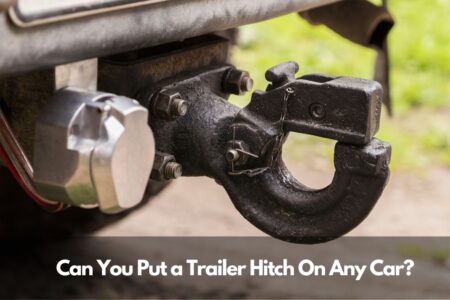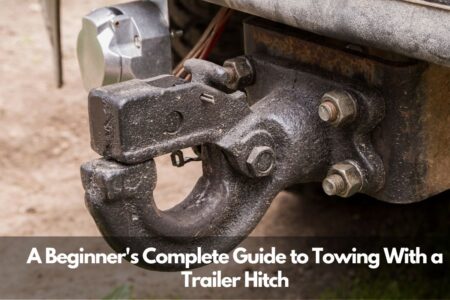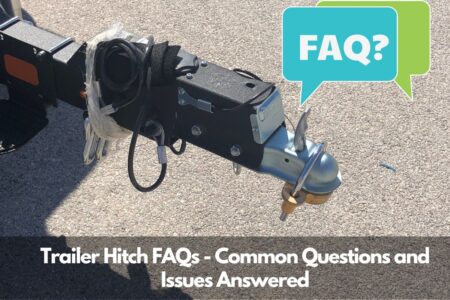
Weight distribution (WD) hitches are essential tools for safely towing heavier trailers. But how exactly does the system of spring bars and leverage brackets actually shift weight and improve handling?
This guide provides a detailed technical explanation of the mechanics and physics behind weight distribution hitch operation:
Problems With Towing Heavy Trailers
Towing a trailer that weighs a significant portion of the tow vehicle’s own weight can create major vehicle stability and control issues:
- The rear end sags, lowering the front end height
- The steering feels light and wanders on the road
- The braking performance feels spongy and extended
- The trailer tends to sway from side to side
These all result from the trailer tongue weight compressing the rear suspension and altering weight balance. A standard hitch only connects the trailer load at one point on the rear axle.
Weight distribution hitches help resolve these issues using leverage.
A must read article: A Beginner’s Complete Guide to Towing With a Trailer Hitch
What is Weight Distribution?
Weight distribution refers to balancing trailer tongue weight across both the front and rear axles of the tow vehicle rather than concentrating it on just the rear suspension.
This evens out the weight bearing on all tires for:
- Restored rear suspension height
- Proper front end height for steering responsiveness
- Even brake pressure distribution for stopping power
- Lessened trailer sway tendencies
In short, the trailer tongue weight gets “distributed” to the front axle rather than only the rear axle.
Key Components of Weight Distribution Hitches
Weight distribution relies on a system of structural components:
- Hitch head – Bars slide into this receiver mounted on the tow vehicle
- Spring bars – Angled bars that connect the hitch head to the trailer
- Trailer brackets – Attach spring bars to brackets mounted on the trailer A-frame
- Friction sway control – Provides additional damping force between the hitch ball and trailer tongue
Together, these components use the trailer’s tongue weight to leverage the tow vehicle suspension and redistribute that weight forward.
How Weight Distribution Hitches Transfer Weight
When a heavy trailer pushes down on the hitch ball, it exerts a strong moment force that compresses the rear suspension. The spring bars transfer some of this downward and rearward force to the front axle using angled brackets as levers and pivots.
Here is the step-by-step process:
- The loaded trailer tongue pushes the tow ball down, compressing rear suspension
- The spring bars link this downward motion to the hitch head
- The angle and shared connection distribute force both rearward and forward
- The hitch pivots, pushing the front edge of the head upward
- This lifts up under the front suspension, decompressing it
- Load transfers from the rear axle to the front axle
In essence, the spring bar linkage takes the trailer’s tongue load and redirects some of it forward into the front axle. This evens out the overall suspension loading.
Trailer and Tow Vehicle Leveling Effects
When set up properly, the weight distribution hitch has two visible effects:
1. The trailer sits level
Since the spring bars transfer more load into the front axle, it reduces the rear axle loading. This allows the trailer to ride evenly parallel to the ground rather than tilting down in back.
2. The tow vehicle rides level
By decompress the rear suspension and placing more weight on the front axle, the overall chassis regains its normal ride height from front to back.
A driver can verify proper hitch adjustment by placing levels on the trailer tongue and tow vehicle. When distributed right, both should sit evenly horizontal front to back when hitched.
Adjusting Weight Distribution
The tension in the spring bar chains determines how much weight gets transferred forward. Tightening or loosening the chains adjusts tongue weight distribution.
To set up weight distribution:
- Measure loaded trailer tongue weight with scales
- Connect spring bars at proper height to trailer brackets
- Adjust chains progressively tighter until tow vehicle levels out
- Check trailer also sits horizontal
- Road test handling and make final spring bar tension tweaks
Setting up weight distribution takes some trial and error. The goal is returning the vehicles to their original unloaded ride heights.
Why Friction Sway Control Improves Stability
In addition to load sharing, weight distribution hitches reduce trailer swaying using principles of rotational friction force.
The friction sway control bars press the trailer coupler tightly down onto the ball. This pressure creates resistance that dampens any oscillating or swaying movements between the trailer and tow vehicle.
With proper setting, the increased friction threshold prevents the tiny back and forth motions that lead to trailer sway. But the friction bars still allow controlled turns and maneuvering when trailering.
Together, the spring bars and friction sway control give both weight-based and motion-based stability improvements when towing heavy trailer loads.
Weight Distribution Hitch Maintenance
Weight distribution hitches require occasional maintenance for smooth operation:
- Clean spring bars and lubricate ends monthly to prevent rust seizing the pivots
- Check for cracking or bending of steel components over time
- Inspect nylon bushings in shanks – replace if excessively worn
- Confirm all bolts and chains remain tightened to specified torques
- Touch up any scratches or nicks in metal parts to prevent corrosion
- Grease hitch ball and friction sway ball to promote smooth rotation
- Have hitch inspected annually by a professional installer
Proper weight distribution hitch care ensures the system functions as designed trip after trip.
Weight Distribution Hitch Adjustment Troubleshooting
If the hitch isn’t providing proper weight distribution, try these troubleshooting tips:
Trailer still tilting back
- Increase spring bar chain tension to transfer more weight forward
Tow vehicle front end still sagging down
- The bars may be too short – upgrade to longer bars for proper leverage
Trailer sway not eliminated
- Chains could be too loose – increase tension for more sway damping
Harsh ride or vibration
- Chains are likely overtightened – back off tension slightly until it rides smoothly
Taking the time to tune the weight distribution system makes towing much safer and more controlled. Don’t hesitate to have a professional evaluate the setup.
Is a Weight Distribution Hitch Right for Your Towing Needs?
The best candidates for weight distribution hitch systems are:
- Heavier trailers exceeding 50% of tow vehicle weight
- Longer trailers 18 ft and over
- Bumper pull trailers rather than fifth wheels or goosenecks
- Tow vehicles prone to squat and instability like SUVs and half-ton pickups
While not mandatory in all cases, weight distribution hitches greatly benefit handling, safety, and durability anytime significant tongue weight comes into play.
Weighing Your Trailer Properly
No towing system upgrades will help if the trailer is overloaded beyond vehicle and hitch limits. Always:
- Weigh the fully loaded trailer and tongue on scales
- Compare to manufacturer gross vehicle and tow ratings
- Distribute cargo to remain under all limits
There is no substitute for weighing. It takes just minutes but provides critical data on how to operate safely.
Investing in a complete weight distribution hitch system pays dividends for years through enhanced tow vehicle stability, easier driving, and reducing wear on components. This detailed guide on the mechanical principles and proper operation helps ensure you maximize their capabilities. Understanding exactly how the load sharing, leveling, and friction sway control functions builds knowledge for smarter towing.
For more issue, consult to this article: Trailer Hitch FAQs – Common Questions and Issues Answered





